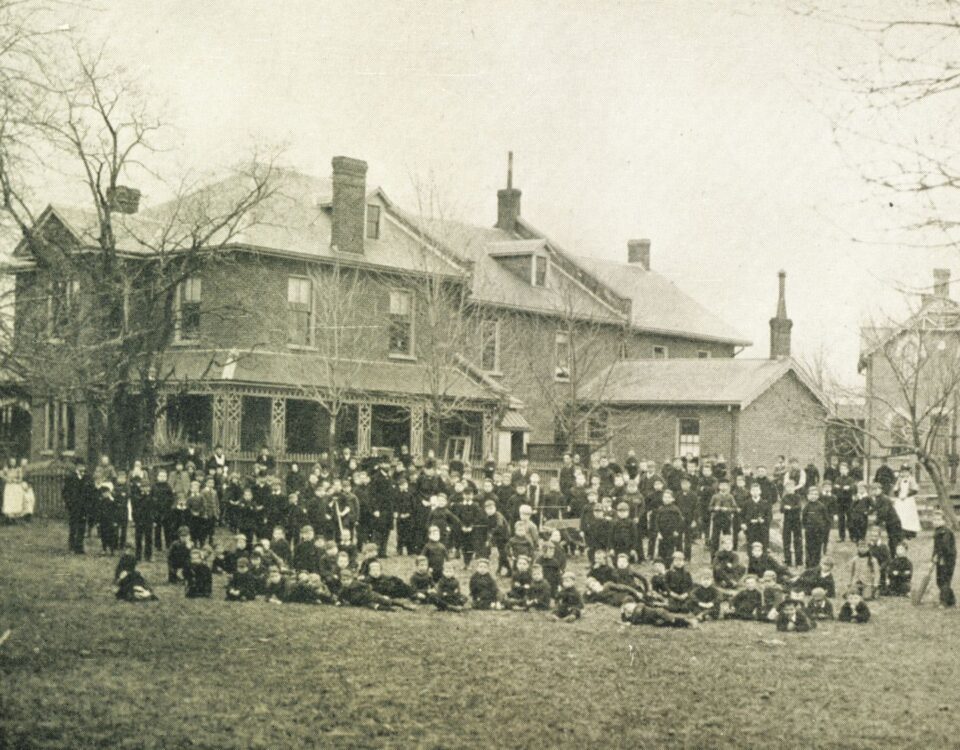
What is the link between Charles Dickens and the Marchmont Home in Belleville? The answer is a deep concern for the welfare of the orphaned, impoverished and abandoned children, many from destitute families, forced into the crowded streets of the newly industrialized cities of Britain. Through the mid-1800s Dickens wrote 15 novels. He was not simply writing to entertain the upper classes, but as a perceptive social critic, campaigning for children’s rights, education and reform. The stories of David Copperfield and Oliver Twist set in bold relief the terrible state of the teeming urban slums of Britain where thousands of children were doomed to a miserable existence either labouring in factories or derelicts in the streets.
Children eight to ten years of age laboured making match boxes, pasting the sandpaper on the boxes. Other children worked in coal mines and giant factories with long hours and paltry payment. In A Christmas Carol, Dickens lamented that the prisons, Union workhouses and the Treadmill and Poor Laws were still pursuing “their useful course.” The problem of extreme poverty existed across Britain, particularly in the east end of London while the situation in Liverpool was exacerbated by the influx of thousands of impoverished Irish at the time of the Great Potato Famine.
Faced with this disastrous situation, a number of charitable organizations under the leadership of deeply concerned individuals established homes in which children could receive education and training. Many were relocated to the newly developing countries like Canada, Australia and New Zealand where it was believed they would have the opportunity for a successful life. These individuals devoted their entire lives to this cause. More than 100,000 boys and girls, most between the age of 7 to 14, were brought to Canada between 1860 and 1940 under these programs. The Bernardo Homes brought 35,000 children to Canada. 10,000 children were transported to Belleville to the Marchmont Distribution Home between 1870 and 1925, the boys being placed with local farming families and the girls as domestic workers.
The first small group of children arrived in 1870 under the care of Annie McPherson and were immediately placed on local farms. It was recognized that permanent receiving homes would be required to give the children a place to settle in upon their arrival. That same year, Hastings County, supported by Senator Billa Flint, offered McPherson a home rent-free, the first Marchmont Home, to receive the new arrivals and prepare them for their placements. Marchmont was managed by Ellen Bilbrough. During that year three groups totalling 273 boys and girls arrived. By 1872, the annual arrival of children increased to 371 and the flow of children continued for another 50 years. Farmers were informed of the availability of the children and they applied in large numbers. They were required to sign a contract which indentured the child to the farmer until the age of 18 and included arrangements for wages, clothing, food, shelter and work.
In 1872, the first Marchmont Home on Highland Avenue burned; however, the community came together and a very large and spacious house on West Moira Street was purchased by Billa Flint and other supporters and was furnished by the ladies of Belleville. This building, a wooden structure, was destroyed by fire in 1875 and, once again, the people of Belleville raised the funds to rebuild the home, this time using brick and fire-resistant material.
The struggles were indeed difficult for many. The boys, raised in the tumultuous city streets, often small and undernourished, struggled to adapt to the demanding labor of farm work, frequently under harsh masters and facing tasks beyond their training or physical capability. Conditions of life on the farms were primitive, often with little pay or appreciation. Similarly, young girls, unfamiliar with normal domestic life, encountered rough treatment and extreme work demands in their new homes. Many children endured loneliness, isolation, and often faced prejudice due to their origins when separated from their homelands and familiar places at such a young age.
However, for many home children, their lives in peaceful and secure environments were considered far superior to the impoverished conditions on the streets of industrial Britain, where they were trapped in filth and poverty and constrained by the rigid class system. There were numerous success stories, with former street children receiving a good education and finding love and care in their new families. Many went on to own farms or pursue careers as teachers, doctors, nurses, clergy, tradespeople, politicians, and in other occupations. A significant number also served in the First World War, with many earning commissions and distinctions, and some ultimately returning to Britain.
In the early years, the transportation and placement of children was largely unregulated, in spite of the best intentions of the charitable organizers. By the 1890s, the movement shifted from a religious/charitable philanthropy to be ruled by government programs, regulations and inspections in both Britain and Canada. Child welfare laws were enacted, including the creation of the Children’s Aid Society.
By 1925, the original operation of Marchmont had transitioned to government programs, as the pioneers of the movement had passed away. That year, after 55 years and having placed 10,000 children, Marchmont closed its doors. The program was amalgamated into the Bernardo organization. It is estimated that about 11 percent of the current population of Canada are descendants of these home children.
The full story of Marchmont is available in the book, Marchmont Distributing Home, Belleville, Ontario, 1870-1925, by James S. Gilchrist through the Hastings County Historical Society.


